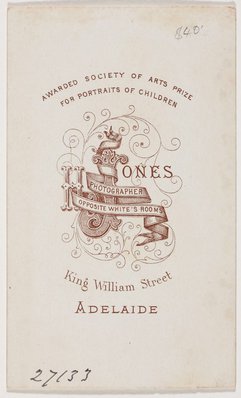-
Details
- Date
- 1870-1871
- Media category
- Photograph
- Materials used
- carte de visite
- Dimensions
- 9.5 x 5.9 cm image; 10.1 x 6.4 cm mount card
- Signature & date
Not signed. Not dated.
- Credit
- Purchased 2014
- Location
- Not on display
- Accession number
- 381.2014
- Copyright
- Artist information
-
Henry Jones
Works in the collection
- Share
-
-
About
Henry Jones was a professional photographer based in Melbourne and Adelaide. Born in England in 1826, he arrived in Victoria with his family in the late 1850s. In 1859 he established a studio, advertising his services as a daguerreotypist and photographic artist, and began producing pannotypes, photographs printed on leather which were possible to send through the post. Jones worked from a number of different addresses in Melbourne before moving to Adelaide to work as a camera operator for Townsend Duryea in 1866. In 1870 he opened his own studio in Adelaide in conjunction with a watchmaking and jewellery business. From this location Jones produced a pair of large mosaics, composite images made of hundreds of tiny paper photographs of men and women who had attended the ‘Old Colonists’ banquet in 1871. The mosaics were received as valuable mementos of the pioneer colonists of South Australia. On the strength of this project, Jones received a vice-regal commission to photograph the Governor of South Australia, Sir Anthony Musgrave. In addition to his official, memorial work, Jones also specialised in photographs of children, and renamed his firm The Children’s Photographic Company in 1879.
A carte de visite is a stiff card of about 10 x 6.4 cm, with an attached paper photograph, invented in 1854 by André-Adolphe-Eugène Disderi. They were introduced into Australia in 1859 by William Blackwood with albums arriving in 1860, aiding the collection and distribution of multiple cartes. Cartes were usually portraits and were made by the millions worldwide. Multi-lens, or ‘multiplying’ cameras were introduced in the 1860s, which were capable of producing from 2 to 32 images in quick succession, dramatically increasing the number of cartes de visite that could be made from a single photographic plate. They were easily reproduced by making paper contact prints from the glass plates, which were then cut and pasted to card.
-
Exhibition history
Shown in 2 exhibitions
The photograph and Australia, Art Gallery of New South Wales, Sydney, 21 Mar 2015–08 Jun 2015
The photograph and Australia, Queensland Art Gallery, South Brisbane, 04 Jul 2015–11 Oct 2015
Hold still: the photographic performance, Art Gallery of New South Wales, Sydney, 12 May 2018–29 Jul 2018
-
Bibliography
Referenced in 1 publication
-
Judy Annear, The photograph and Australia, Sydney, Jun 2015, 245 (colour illus.).
-

